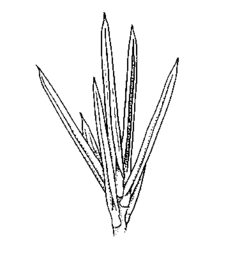Grevillea juniperina subsp. fortis Makinson APNI* 
Description: Robust shrub 1–3 m tall; branches ascending to spreading (often arching upwards), appearing columnar (leaves mostly clustered on short lateral branchlets); foliage often in pseudo-whorls.
Adult leaves dark green, linear to subulate, 10–20 (-26) mm long, (0.7-) 1–1.4 (-2) mm wide, angularly deltoid to trigonous (rarely convex-upwards) in cross-section; upper surface with 1–3 prominent longitudinal veins; margins angularly to smoothly revolute; lower surface densely subsericeous, often mostly or wholly obscured by margins; juvenile leaves sometimes slightly broader than adults (1.5–3 mm wide), with strongly revolute margins.
Perianth densely to openly subsericeous with biramous hairs only. Flower colour: perianth red or rarely pink (very rarely yellow); style red (rarely pink or yellow). Pistil 19–27 mm long.
Flowering: Flowers mostly August–September, sporadically in other months.
Distribution and occurrence: Known from the A.C.T. area, where it occurs along Ginninderra Ck, lower reaches of the Molonglo and Cotter R., and the Murrumbidgee R. from the Molonglo confluence upstream to Pine Is. There is also a single record from much further upstream on the Murrumbidgee River. Grows in open dry sclerophyll forest, woodland, and shrubland, often in rocky situations, along banks or slopes above permanent watercourses, at altitudes of 450-750 m.
NSW subdivisions: ST
Text by R.O. Makinson
Taxon concept: R.O. Makinson (Fl. Australia)
APNI* Provides a link to the Australian Plant Name Index (hosted by the Australian National Botanic Gardens) for comprehensive bibliographic data
***The AVH map option provides a detailed interactive Australia wide distribution map drawn from collections held by all major Australian herbaria participating in the Australian Virtual Herbarium project.
|


